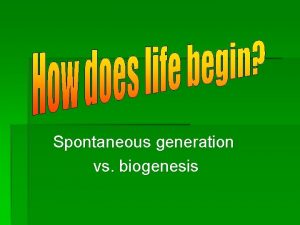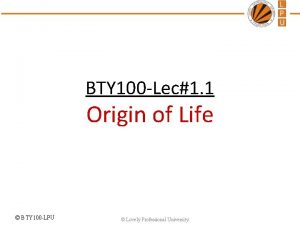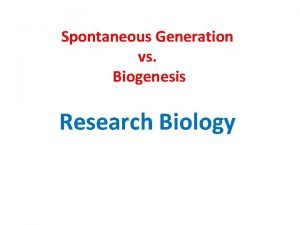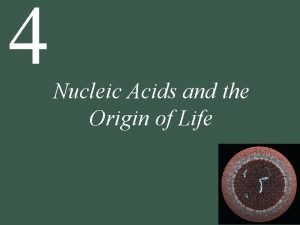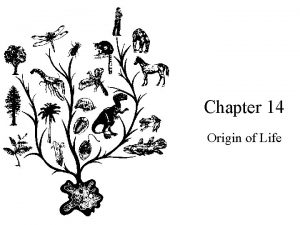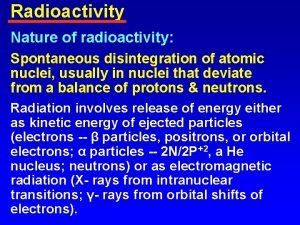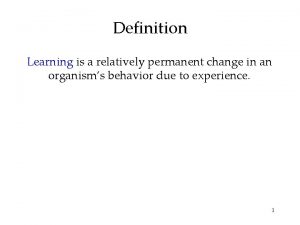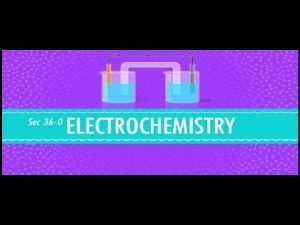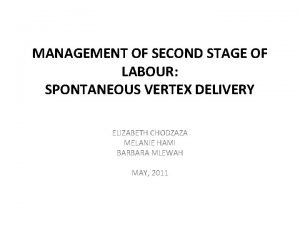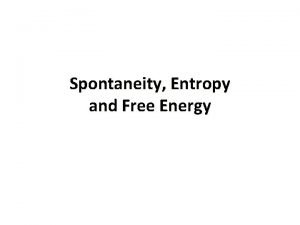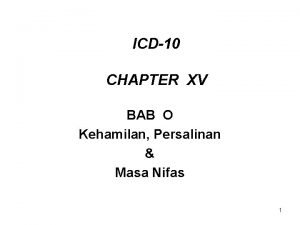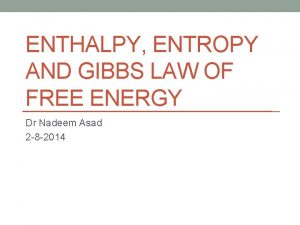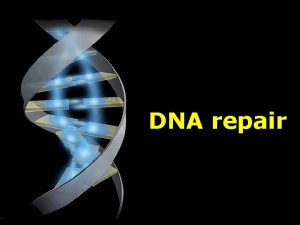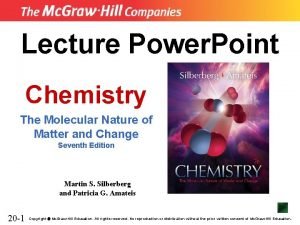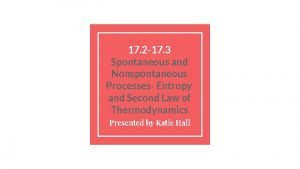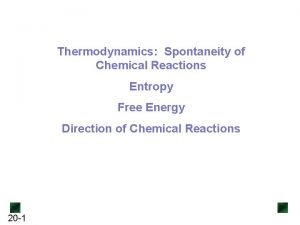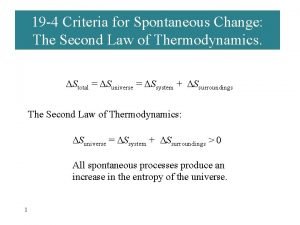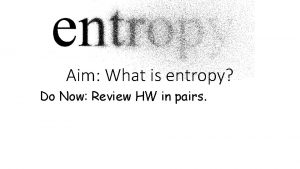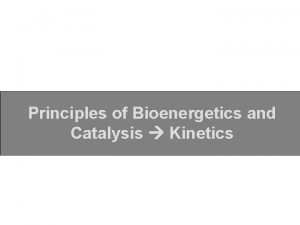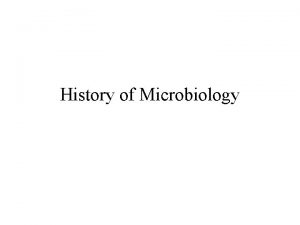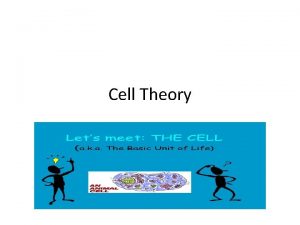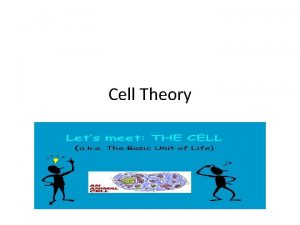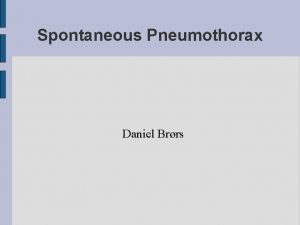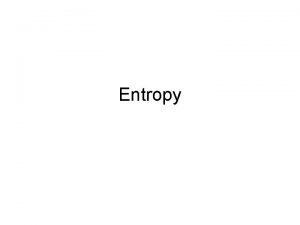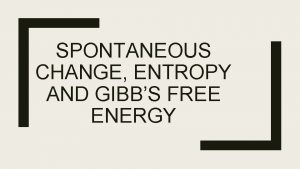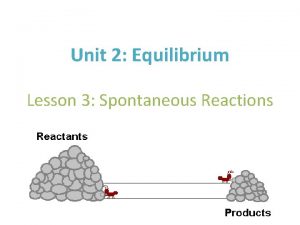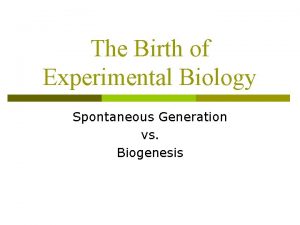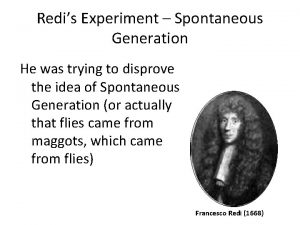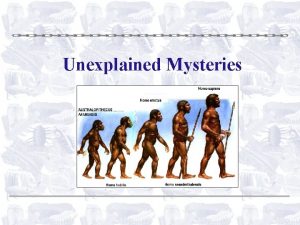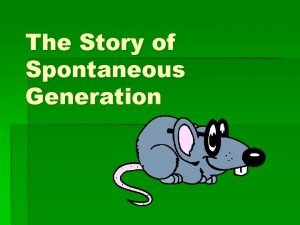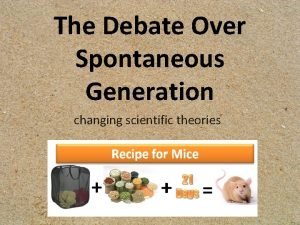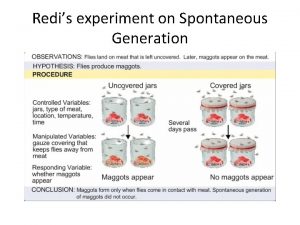Spontaneous Generation Spontaneous Generation Spontaneous Generation Spontaneous Generation











































- Slides: 43




Spontaneous Generation?

Spontaneous Generation?

Spontaneous Generation?

Spontaneous Generation?

Spontaneous Generation?

If not Spontaneous Generation, then what?

If not Spontaneous Generation, then what? Biogenesis


Steps in hypothesis about how first cells formed:

Steps in hypothesis about how first cells formed: 1. Synthesis of simple organic molecules

Steps in hypothesis about how first cells formed: 1. Synthesis of simple organic molecules (carbon based molecules).

Steps in hypothesis about how first cells formed: 1. Synthesis of simple organic molecules (carbon based molecules). ancient oceans before life were full of organic molecules, including:

Steps in hypothesis about how first cells formed: 1. Synthesis of simple organic molecules (carbon based molecules). ancient oceans before life were full of organic molecules, including: nucleotides (building blocks for RNA and DNA)

Steps in hypothesis about how first cells formed: 1. Synthesis of simple organic molecules (carbon based molecules). ancient oceans before life were full of organic molecules, including: nucleotides (building blocks for RNA and DNA) amino acids (building blocks for proteins)

Steps in hypothesis about how first cells formed: 1. Synthesis of simple organic molecules (carbon based molecules). ancient oceans before life were full of organic molecules, including: nucleotides (building blocks for RNA and DNA) amino acids (building blocks for proteins) we call the condition of the ancient oceans "primordial soup. "

Steps in hypothesis about how first cells formed: 1. Synthesis of simple organic molecules.

Steps in hypothesis about how first cells formed: 1. Synthesis of simple organic molecules. 2. Formation of polymers (chains of organic molecules), including:

Steps in hypothesis about how first cells formed: 1. Synthesis of simple organic molecules. 2. Formation of polymers (chains of organic molecules), including: proteins

Steps in hypothesis about how first cells formed: 1. Synthesis of simple organic molecules. 2. Formation of polymers (chains of organic molecules), including: proteins RNA, which can help proteins form

Steps in hypothesis about how first cells formed: 1. Synthesis of simple organic molecules. 2. Formation of polymers (chains of organic molecules), including: proteins RNA, which can help proteins form Lipids (fatty compounds)

Steps in hypothesis about how first cells formed: 1. Synthesis of simple organic molecules. 2. Formation of polymers (chains of organic molecules)

Steps in hypothesis about how first cells formed: 1. Synthesis of simple organic molecules. 2. Formation of polymers (chains of organic molecules) 3. Formation of membranes.

Steps in hypothesis about how first cells formed: 1. Synthesis of simple organic molecules. 2. Formation of polymers (chains of organic molecules) 3. Formation of membranes. When lipids and proteins are mixed with water, membranes form.

Steps in hypothesis about how first cells formed: 1. Synthesis of simple organic molecules. 2. Formation of polymers (chains of organic molecules) 3. Formation of membranes. 4. Beginning of replication and heredity. RNA can copy itself and was likely the first molecule to do so.

Steps in hypothesis about how first cells formed: 1. Synthesis of simple organic molecules. 2. Formation of polymers (chains of organic molecules) 3. Formation of membranes. 4. Beginning of replication and heredity.

How did life originate? David Attenborough- Origin of Life, Arrival HD - BBC Documentary - Animals & Nature. mp 4



Precambrian Era

Precambrian Era Paleozoic Era

Paleozoic Era Mesozoic Era Precambrian Era

Precambrian Era Cenozoic Era Mesozoic Era Paleozoic Era Flowering plants, birds Dinosaurs extinction Mammal diversification, then humans First dinosaurs, mammals Gynosperms, Amphibians, then reptiles Fish Moss, arthropods, fungi on land Earliest multicellular organisms Protists (algae and protozoa) Eukaryotic cells Cyanobacteria (photosynthesis) Prokaryotes (bacteria) Earth Forms

Teacher. Trek Powerpoint. ppt


Precambrian Era First Cells Prokaryotes Bacteria Eubacteria Cyanobacteria Archaebacteria Eukaryotes Fungi-like cells Fungi Animal-like cells Invertebrates Plant-like cells Green Algae

Invertebrates Vertebrates Fish Amphibians Reptiles Green algae Moss, etc. Fern ancestor Ferns "Seed Ferns" Gymnosperms (pines, etc. )

Reptiles Mammals Gymnosperms Dinosaurs Angiosperms (flowering plants) Birds Humans



Attachments David Attenborough- Origin of Life, Arrival HD - BBC Documentary - Animals & Nature. mp 4 Teacher. Trek Powerpoint. ppt
 Spontaneous generation vs biogenesis
Spontaneous generation vs biogenesis Prebionts
Prebionts Whats spontaneous generation
Whats spontaneous generation Spontaneous generation vs biogenesis worksheet answers
Spontaneous generation vs biogenesis worksheet answers Disproving spontaneous generation
Disproving spontaneous generation Four model approach
Four model approach What did spallanzani do to improve upon redi's
What did spallanzani do to improve upon redi's The slow death of spontaneous generation
The slow death of spontaneous generation Whats spontaneous generation
Whats spontaneous generation Louis lerman experiment conclusion
Louis lerman experiment conclusion Spontaneous generation in data flow diagram
Spontaneous generation in data flow diagram From generation to generation we worship you
From generation to generation we worship you Second generation vs first generation antipsychotics
Second generation vs first generation antipsychotics Are spontaneous reactions reversible
Are spontaneous reactions reversible Spontaneous pneumothorax
Spontaneous pneumothorax Radioactivity as spontaneous disintegration
Radioactivity as spontaneous disintegration How to find free energy
How to find free energy A relatively permanent change of behavior is called
A relatively permanent change of behavior is called Why are galvanic cells spontaneous
Why are galvanic cells spontaneous Spontaneous fission definition
Spontaneous fission definition Spontaneous vertex delivery
Spontaneous vertex delivery Current liabilities management
Current liabilities management Non spontaneous process
Non spontaneous process Spontaneous reaction chemistry
Spontaneous reaction chemistry Classify each process as spontaneous or nonspontaneous.
Classify each process as spontaneous or nonspontaneous. Spontaneous recovery psychology
Spontaneous recovery psychology Non spontaneous process examples
Non spontaneous process examples Spontaneous transmutation
Spontaneous transmutation Spontaneous pneumothorax
Spontaneous pneumothorax Icd 10 partus spontan
Icd 10 partus spontan Is delta g spontaneous
Is delta g spontaneous Smyths model of reflection
Smyths model of reflection What is spontaneous mutation
What is spontaneous mutation K=e^-g/rt
K=e^-g/rt Spontaneous reactions
Spontaneous reactions Non spontaneous process definition
Non spontaneous process definition Non spontaneous process
Non spontaneous process Supply and demand matching
Supply and demand matching Spontaneous process in thermodynamics
Spontaneous process in thermodynamics Criteria for spontaneous process
Criteria for spontaneous process Tgcsa grading plaque
Tgcsa grading plaque Which tendencies favor a spontaneous reaction
Which tendencies favor a spontaneous reaction Verbal spontaneous problems
Verbal spontaneous problems Spontaneous reactions
Spontaneous reactions
